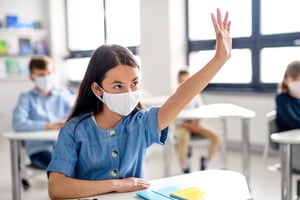CDC Considerations for Student COVID-19 Testing
published on August 13, 2020 by Sonia Mastros
school bus safety, school bus safety plans, student covid-19 testing, covid-19
 What do you do if you suspect a student coming to school in the fall has the COVID-19 coronavirus or may have been exposed to it? Districts across America are asking this question. Fortunately, they have some guidance. The Centers for Disease Control (CDC) recently released a series of recommendations on how to handle these situations.
What do you do if you suspect a student coming to school in the fall has the COVID-19 coronavirus or may have been exposed to it? Districts across America are asking this question. Fortunately, they have some guidance. The Centers for Disease Control (CDC) recently released a series of recommendations on how to handle these situations.
While these recommendations are largely framed around students, nearly everything the CDC recommends could also be applied to teachers or other staff.
Isolate Upon Detection
One of the most important recommendations is that if a student begins to show symptoms of the coronavirus, especially a high fever or coughing, they should be immediately isolated. If possible, have a small room set aside specifically for daytime quarantines, where the student can stay until their parents can retrieve them.
If the student is already on a bus when they start showing symptoms, the driver or attendants should still do their best to isolate the student. Provide them with a mask and gloves, and rearrange the bus seating so that they are at least six feet from any other student.
Testing Options
Depending on your school's facilities, it may or may not be viable to provide COVID-19 testing on-site. If it is possible, there are two basic options:
- Viral tests will directly test to see if the student is carrying a viral load, which determines whether they are infected - and, accordingly, whether they're infectious.
- Antibody tests are for testing students who might have had the coronavirus in the past, as it looks for antibodies to the virus created by the student's immune system.
Remember: because COVID-19 has an extended incubation period of 2-3 weeks, where the individual is infected but does not display symptoms, you will not be able to keep all infected students out of the building. Testing will only, at best, confirm current cases.
Tracing Contacts
Depending on your local or state laws governing student privacy, it may be prudent for schools to attempt to trace previous contacts when a student is identified as carrying the coronavirus. If a student is found to be infected, try to get an account of their movements in the previous couple of weeks, and which other students they may have come into contact with.
In turn, those who were in contact with the infected student should be tested themselves. They will be at the highest risk of carrying the coronavirus or potentially even spreading it to more people.
Constant oversight and vigilance will be required to prevent major outbreaks at school. How will your district be handling these matters? Please share your tips and insights below - for everyone's sake.





